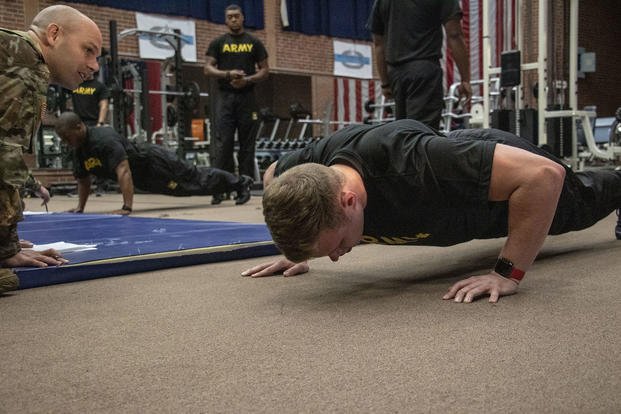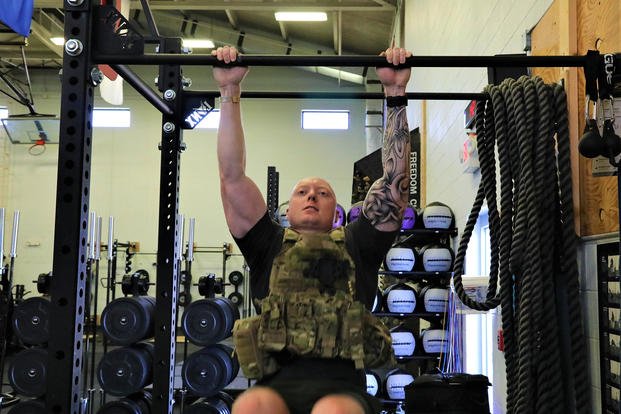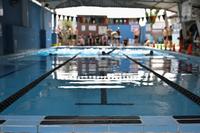To enter into the military and after every six months, members must pass the fitness test. Depending upon the branch of service, the PT tests vary in exercises, timed events and run distances. Typically, there are three groups of test takers when scoring the test.
You will have the following:
Failures and Borderline Failures
Some people strive for the minimum standards on fitness tests. A borderline pass/fail should not be anyone's goal. If you have a bad day (like we all do), you easily could be on the failing end of that test.
After failing, some military units require you to work out with someone else, who is in charge of your passing the next fitness test. Now you are on their time. The 5 a.m. wakeup calls for remedial PT sessions have begun. The problem is that no one wants to be there.
Ideas on Ways to Train: Running, push-up, pull-up and sit-up failures and learning how to train.
If injured or severely ill for a significant time, see how to build back up to passing standards.

Comfortable Passing Zone
The majority of service members are passing the standards rather easily each cycle by exercising regularly, avoiding overeating and just staying active. The tests are not designed for the world-class athlete, and anyone can be fit and even obtain advanced levels of fitness.
Some basic daily habits of working out will get you into the comfortable passing zone. Check out this related article on methods to improve steadily or maintain your goal fitness standards throughout your career:
The Classic PT Workout: If you do this PT Pyramid once a week, with other sports or weight training mixed into the week, you will be in the passing zone of PT tests constantly and never have to worry about failing a fitness test. Many people like this workout so much, they do it every other day and get creative with weights, kettlebells, other calisthenics and core exercises.
Those Who Strive to Max the Test
There is a group of people who train hard several days a week, crush any PT test and take these events as a personal challenge. This attitude is particularly common in military members, highly competitive spirits and those seeking advanced training programs within the military that require challenging selection programs.
Pushing the PT/Running Limits: If you are in this group, you may want your workouts tough. Here is a way to mix in sprints with goal-paced running while adding in calisthenics testing events as well.
Max-Rep Sets: If you are focusing on peaking with your PT scores, the max-rep set workout is a way to reach maximum-level scores relatively quickly if you are already in the intermediate level of fitness. This one is not for beginners.
Training for Timed Runs: Whether you are just trying to reach the passing stages or want to be the fastest runner in your group, these workouts will get you there. The only difference is the amount of effort, speed and pace you put into each running workout.
Acing the Sit-ups: Nearly every fitness test has some form of core strength exercise, usually crunches or sit-ups. If you want to ace the sit-ups and score in the 100-plus range in two minutes or 60-plus range in one minute, you need to commit your goal pace to muscle memory. Whether you want to just pass or max the test, the difference is your pace. Focus on what your pace is every 30 seconds.
If your goal is to do 80 sit-ups in two minutes, your pace is 20 sit-ups in 30 seconds for a two-minute test. If maxing the test requires 100 sit-ups in two minutes, shoot for 25 reps every 30 seconds. And practice at that pace. You can even "rest with 30-second sit-ups/crunches sets" between weight-room lifts, calisthenics sets or running intervals. The trick to acing sit-ups is to learn your pace, build your one- to two-minute foundation at that pace and stick to it.
Flexibility of the trunk and legs requires daily stretching and training in strength and flexibility. Ending workouts or doing stretching and mobility days during the week are recommended. See ideas for a full-core workout or stretching routine, such as the Lower Back Plan

Maxing Push-ups and Pull-ups
Building upper-body strength is key to success. Whether that is a foundation in weight training first or strictly body-weight calisthenics, you have to turn these strength exercises into endurance exercises eventually and maintain push-ups and pull-ups at a steady pace for 1-2 minutes. Building muscle endurance to last two minutes to max the test will take some effort, but it can be done in a few months of consistent training.
Proper Form: A helpful method to learning how to do push-ups properly and using chest, shoulders and triceps together to maximize your effort.
Some classic training ideas for all events (push-ups, sit-ups and pull-ups):
PT Pyramid: To make this workout harder, add quarter-, half- or one-mile runs at your goal pace every five minutes.
PT Superset: To make this workout harder, add quarter-, half- or one-mile runs at your goal pace every five minutes.
Here is an example of a way to put it all together in what is called the Classic PT Test Training Week for acing fitness tests.
It is not recommended to train for a PT test year-round, but a cycle of 6-8 weeks or less will put you in a solid PT test mode. After the testing cycle, you should be doing other workouts that help you with the performance of your actual job in the military. If your job is extremely physical and your fitness can make the difference between life and death, then by all means, focus on all the elements of tactical fitness:
- Strength
- Power
- Endurance
- Muscle stamina
- Speed
- Agility
- Flexibility
- Mobility
Stew Smith is a former Navy SEAL and fitness author certified as a Strength and Conditioning Specialist (CSCS) with the National Strength and Conditioning Association. Visit his Fitness eBook store if you're looking to start a workout program to create a healthy lifestyle. Send your fitness questions to stew@stewsmith.com.
Want to Learn More About Military Life?
Whether you're thinking of joining the military, looking for fitness and basic training tips, or keeping up with military life and benefits, Military.com has you covered. Subscribe to Military.com to have military news, updates and resources delivered directly to your inbox.


















